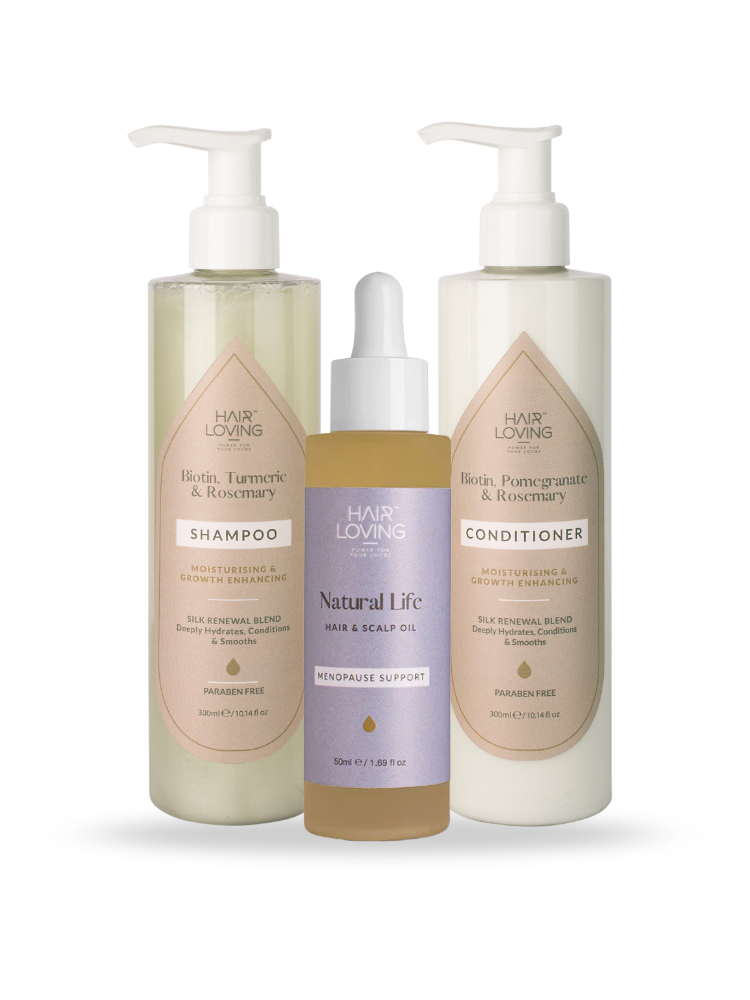Hair is more than just a defining feature of our appearance; it's a complex structure playing a vital role in protecting our scalp and regulating body temperature. Understanding the anatomy of hair can help us grasp why hair loss occurs at different stages of life, particularly during postpartum, menopause, and other significant phases for both men and women.
The Anatomy of Hair
Hair is composed of two main structures: the hair follicle and the hair shaft.
-
Hair Follicle: This is a tunnel-like segment located in the skin's epidermis. It extends down into the dermis and is the site where hair growth begins. The follicle is surrounded by a root sheath, and it houses the hair bulb, which contains the cells that produce the hair shaft.
-
Hair Shaft: The visible part of the hair that extends above the skin's surface. It is made of a protein called keratin, which is also found in nails and the outer layer of skin. The hair shaft consists of three layers:
- Cuticle: The outermost layer, made of overlapping cells that protect the hair.
- Cortex: The middle layer, which provides strength, color, and texture to the hair.
- Medulla: The innermost layer, which is not always present in every hair type.
Hair Growth Cycle
Hair growth follows a cycle with three main phases:
- Anagen Phase: The growth phase, lasting 2-7 years. The longer the hair remains in this phase, the longer it will grow.
- Catagen Phase: The transitional phase, lasting about 2-3 weeks. Hair growth slows, and the follicle shrinks.
- Telogen Phase: The resting phase, lasting about 3 months. Hair does not grow but remains attached to the follicle. At the end of this phase, the hair falls out, and a new hair begins to grow.
Hair Loss Across Life Stages
Postpartum Hair Loss
Postpartum hair loss is a common experience for new mothers. During pregnancy, high levels of oestrogen prolong the anagen phase, leading to thicker, fuller hair. After childbirth, oestrogen levels drop, causing a significant number of hairs to enter the telogen phase simultaneously. This can result in noticeable hair shedding about three months postpartum, which typically resolves within 6-12 months as hormone levels stabilize.
Menopausal Hair Loss
Menopause brings a decline in oestrogen and progesterone levels, leading to an increase in the effects of androgens (male hormones). This hormonal shift can cause hair follicles to shrink, leading to hair thinning and increased shedding. Unlike postpartum hair loss, menopausal hair loss can be more prolonged and may require treatments like hormone replacement therapy, topical minoxidil, or lifestyle changes to manage.
Hair Loss in Men and Women Across Other Life Stages
-
Androgenetic Alopecia: This genetic condition affects both men and women, often leading to male-pattern baldness and female-pattern hair loss. It typically begins in the 20s or 30s but can start earlier or later. In men, it usually results in a receding hairline and bald spots, while women experience diffuse thinning on the crown.
-
Telogen Effluvium: A temporary form of hair loss often triggered by stress, illness, surgery, or significant life events. It causes a large number of hairs to enter the telogen phase prematurely, leading to diffuse shedding.
-
Alopecia Areata: An autoimmune condition where the body's immune system attacks hair follicles, causing patchy hair loss. It can occur at any age and may be triggered by stress or illness.
Managing Hair Health Through Life
Maintaining healthy hair involves a combination of proper nutrition, gentle hair care practices, and managing stress levels. Here are some tips to support hair health:
- Nutrition: Ensure a balanced diet rich in vitamins and minerals, including iron, zinc, vitamin D, and biotin.
- Hair Care: Use gentle shampoos and conditioners, avoid excessive heat styling, and minimize the use of harsh chemicals.
- Stress Management: Practice relaxation techniques such as yoga, meditation, or regular exercise to keep stress levels in check.
Understanding the anatomy of hair and the factors that influence hair loss can empower you to take proactive steps in maintaining healthy, vibrant hair throughout life's various stages. Whether you're navigating postpartum changes, menopause, or other significant life events, remember that hair loss is often temporary and manageable with the right care and support.





